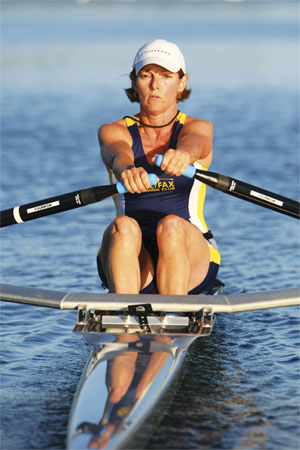 |
| Prof. Katherine Harman used rowing to help her recover from cancer. (Nick Pearce Photo) |
In rowing terms, “recovery” describes a part of the stroke cycle. For Katherine Harman, a rower, it also means coming back from a brush with cancer.
The year she turned 50 didn’t really start out that well. The associate professor of physiotherapy and assistant dean for the Faculty of Health Professions was diagnosed with breast cancer in November and had a mastectomy of her left breast in January.
“It’s really stressful, a cancer diagnosis threatens your whole being,” reflects Dr. Harman during a recent interview. “Having just turned 50 I was thinking I wouldn’t have to face this whole mortality thing for another few decades … It makes you wonder how much longer you have and what you can do about it.”
Although she’s been athletic all her life, Dr. Harman became a rower only a few years ago. After her surgery, she threw herself into a training regime to prepare for the summer rowing season. “For six weeks afterwards, I was not allowed to use my arm, so I did my training one handed … it was definitely my major coping strategy.”
All that training and focus paid off for Dr. Harman when she won her masters event (women’s single in the age category ‘D’ or over 50) at the Royal Canadian Henley Regatta, a prestigious national competition now in its 127th year. But what is truly remarkable is that her time of three minutes, 58 seconds made her the fastest woman single sculler of any age category on the water that day.
“I could hear my name being called and lots of cheers as I was approaching the finish,” says Dr. Harman, who was four seconds ahead of her nearest competitor. “It was just the greatest feeling … and breaking four minutes is just amazing.”
Without the regimen of rowing daily, the encouragement of her coach and rowing partner, Dr. Harman doesn’t think she would have recovered nearly so well from her surgery. Rowing provides a total body workout with the legs, back and arms engaged in the process of making each stroke. While considered a low-impact sport with no body contact or jarring of the joints, it improves both strength and cardiovascular performance.
It’s also a sport for the soul, she adds. She begins each day at 5:30 a.m. on the North-West Arm of Halifax Harbour just before the sun rises over Point Pleasant Park. As she propels the boat swiftly across the water, she delights in watching the osprey dive for fish and looks for the seals that sometimes swim alongside. “It’s a beautiful way to start each day,” she says.
She shares her love of the sport by running an adaptive rowing program out of Halifax Rowing Club, coaching three athletes with disabilities.
It’s been a busy summer of recovery for Katherine, as in addition to rowing, she hiked in the Honduran jungle with her 18 year old daughter (student at Dalhousie) to climb Mount Pichucha, and has just come back from a cycle tour of the Cabot Trail. “I think it’s pretty cool you can do these things when you’re 50,” she adds. “I’m happy to be as well as I am at this age.”
